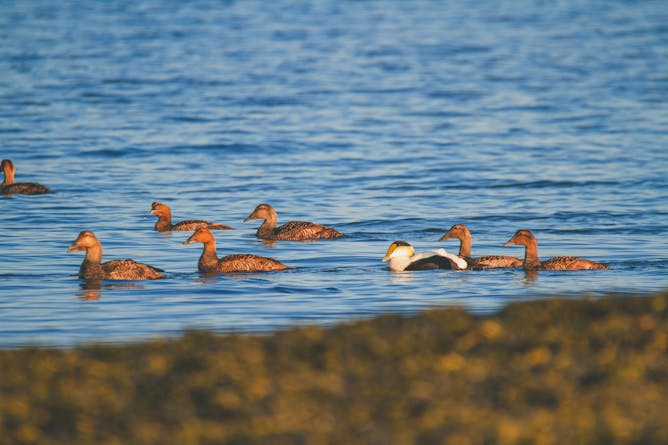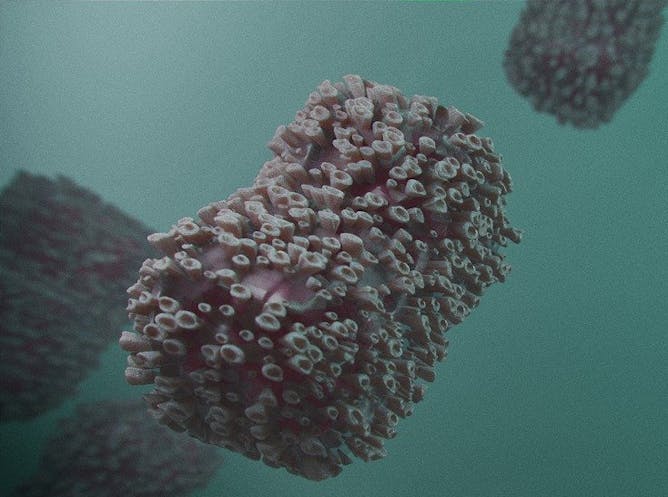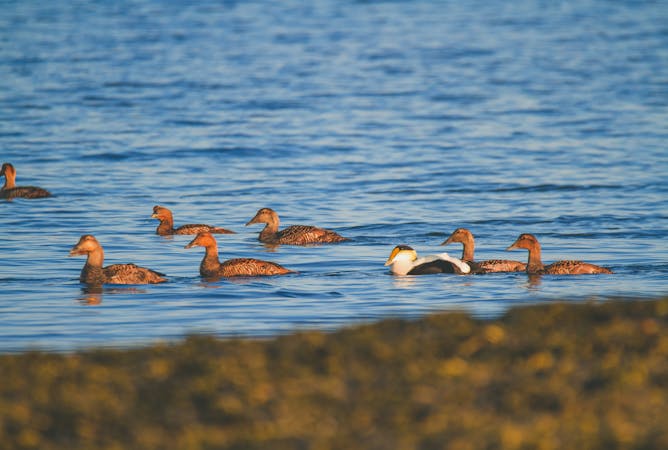|
Today in The Conversation Canada, we present the second article in our series called The St. Lawrence River: In depth. This series is a project by La Conversation Canada and we're translating the articles in English as well.
When I contacted Jean-François Giroux at Université du Québec à Montréal to discuss our St. Lawrence series, I had no idea that our conversation would lead me into a fascinating story about a duck whose generosity helps protect its own species.
The common eider is a sea duck that nests in the Gulf and Estuary of the St. Lawrence River. The eider down that the female removes from her breast to line the nest has exceptional insulating properties. It's used in the production of very expensive bed quilts that are also called "eiderdowns," in reference to the species.
Giroux, a researcher in bird ecology at UQAM, heads a research team that joins the down harvesters, whose work is strictly regulated, in order to monitor the populations. The revenues generated by the commercialization of down have allowed a not-for-profit agency called Société Duvetnor to purchase islands frequented by eiders and other seabird species.
In an extraordinary way, thanks to this organization, the eider is contributing to its own conservation.
Also today:
|

A group of female eider ducks with one male.
(Simon Laroche)
Jean-François Giroux, Université du Québec à Montréal (UQAM)
The common eider nests in colonies on islands of the St. Lawrence estuary. The down that the female duck takes to fill her nest has exceptional insulating properties.
|

Many of the metaphors used to discuss monkeypox evoke a criminal or a rebellious child.
(Pixabay)
Kaitlin Sibbald, Dalhousie University
The metaphors used to characterize monkeypox can contribute to narratives that help sustain racist, colonial, homophobic and other discriminatory attitudes and beliefs.
|

Charles Schwartzel of South Africa celebrates after winning the inaugural LIV Golf Invitational on June 11.
(AP Photo/Alastair Grant)
Brad Millington, Brock University; Brian Wilson, University of British Columbia
For all the efforts at reimagining golf to attract consumer interest, the sportwashing discourse has brought an avalanche of negative attention to the LIV series, and rightfully so.
|

The use of deepfakes by criminals is on the rise, costing individuals and organizations billions of dollars in losses annually.
(Shutterstock)
Nadia Smaili, Université du Québec à Montréal (UQAM); Audrey de Rancourt-Raymond, Université du Québec à Montréal (UQAM)
To combat the rise in deepfakes used in fraud, employees and investigators need to be aware of the threats involved.
|

Team Canada celebrates their gold medal win after defeating the United States at the 2022 Winter Olympics in Beijing.
THE CANADIAN PRESS/Ryan Remiorz
Taylor McKee, Brock University
True gender equity in sport is not simply a matter of paying lip service to equal rights and opportunities. It involves interrogating outdated assumptions and being open to rewriting the rule book.
|

Love stories and moments born out of art, politics and revolution were showcased in ‘Secrets from the Born Settee,’ a 2019 production originated by University of Regina theatre students.
(AV Service/University of Regina)
Taiwo Afolabi, University of Regina; Cali Sproule, University of Calgary; Christine Brubaker, University of Calgary; Ibukun-Oluwa Fasunhan, University of Regina; Yvette Nolan
Reckoning around colonialism, anti-Black racism, and inequality is immense across different fields in our society. The Future Prairie Theatre project is addressing these urgent social struggles.
|

Groupe de femelles eider à duvet avec un mâle.
(Simon Laroche)
Jean-François Giroux, Université du Québec à Montréal (UQAM)
L’eider à duvet est un canard qui niche en colonie sur les îles de l’estuaire du Saint-Laurent. Le duvet que la femelle prélève pour garnir son nid possède des propriétés isolantes exceptionnelles.
|
Ukraine Invasion
|
-
Matthew Sussex, Australian National University
There remains a significant danger the conflict falls off the international radar, or that Western leaders waver as the conflict drags on.
|
|
Arts
|
-
Michael T. Bertrand, Tennessee State University
Presley never wrote a memoir. Nor did he keep a diary. His music could have been a window into his inner life, but he didn’t even write his songs.
|
|
Health
|
-
Gita Mishra, The University of Queensland; Chen Liang, The University of Queensland; Jenny Doust, The University of Queensland
Our study is the first to conclusively show the link between pregnancy loss and stroke risk.
|
|